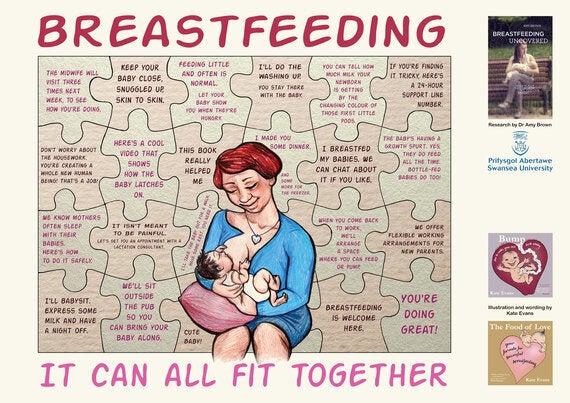
How breastfeeding can fall apart ... and how we can all help piece it back together
Although breastfeeding might be natural, that doesn't mean it is always straightforward. Lots of natural things take practice such as crawling, walking, learning to talk. Likewise, learning how to latch your baby on, recognising those subtle feeding cues and generally feeling more confident in what you are doing can take time. Many women who go on to breastfeed for a long time can remember challenges in those early days and moments when they worried whether they were doing ok.
But saying this, the number of women experiencing difficulties with breastfeeding in the UK and regions such as the USA and Australia is far greater than would be expected. We know that a small percentage of women will be unable to breastfeed because of physiological complications but the gulf between these women and the numbers who stop breastfeeding before they are ready is huge. And 80% of women who stop breastfeeding in the first six weeks are not ready to do so, which can have a lasting impact on their wellbeing.
These figures are particularly stark when you compare them to other countries. Some might argue that almost universal, prolonged breastfeeding in developing countries is due to a life or death need but breastfeeding rates are also far higher in some western regions. Take Norway, Sweden and Denmark for example - almost all mums start breastfeeding with three quarters still doing so at six months (compared to just a third in the UK). That difference cannot be explained purely by an increase in physiological complications - it's experience that matters.
Experience matters
Can a woman's experience of breastfeeding really make that much difference? Yes. Because despite 'breast is best' messages, western culture is often not conducive to breastfeeding. We have strange attitudes about breastfeeding in public. We believe babies should sleep through the night. We pressurise women to 'get their lives and figures back' and worry about mythical 'good babies'. Other people want to feed the baby too. Women often have to go back to work before they are ready due to low paid or even absent maternity leaves. And when new mums do have problems they often can't get the support they need because health professionals are rushed off their feet and breastfeeding support services have been cut.
These experiences all matter. They can directly damage a woman's confidence to breastfeed or ability to breastfeed - or they can work more subtly by persuading her not to feed her baby responsively. Responsive feeding - feeding whenever your baby is hungry rather than at a set time - lies at the heart of successful breastfeeding. The more you breastfeed, the more milk you make. The less you breastfeed, the less you make. This means that when new mums are told not to breastfeed in public or try not to feed their baby at night they can end up making less milk, and feeling they have to stop because they didn't have enough milk. Piece by piece breastfeeding starts to fall apart.

Piecing it back together
But that is only one side of the story. When the situation is reversed and mothers are given good support - both practically from professionals and emotionally from everyone around them, that jigsaw can look very different. When good quality support services are available, when women are well cared for after the birth, when breastfeeding any place any time is supported, when we understand normal breastfed baby behaviour and support mums to feed responsively, when organisations are on board and working together to support extended maternity leave and breastfeeding in the workplace ... then piece by piece, breastfeeding is placed back together.

And it is possible to fix that jigsaw. Some countries have managed to significantly raise their breastfeeding rates by investing at a government level, creating structures and systems that support breastfeeding and changing the way they value new families in general. Take Norway for example - their breastfeeding rates in the 1970s were lower that in the UK. However a series of measures including investment in health professional training, high quality support services for new mothers and extended maternity leave for both mothers and fathers has helped them to have some of the highest breastfeeding rates in the western world.
Similarly, in Brazil, the government invested heavily in promoting breastfeeding including launching media campaigns, training for health workers and the development of mother-to-mother support groups. Policy wise, maternity leave was extended, a crackdown was made on formula advertising and more than 300 maternity hospitals gained Baby Friendly Hospital Initiative certification. Alongside this they set up over 200 human milk banks for sick and premature babies, giving them the highest number in the world.
In both cases, it was the combination of events that worked. Investing from so many different angles at the public health level not only supports women but sends the message to society that breastfeeding matters. It means that everyone gets the message about why breastfeeding is so important rather than mothers alone. As after all, you can encourage mothers to breastfeed all you like, but unless those around them understand and support her decision, continuing will be an uphill struggle. Everyone needs to know why breastfeeding is so important for mums to stand a chance of making this work - because everyone has a role in putting together that jigsaw and creating a supportive environment for breastfeeding.